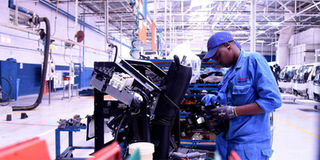Breaking News: At least 10 feared to have drowned in Makueni river
Isuzu says has capacity to make 30 mass transit buses monthly

Isuzu East Africa vehicle assembly plant staff at work on Mombasa Road, Nairobi on Dec 6, 2018. PHOTO | DIANA NGILA | NMG
What you need to know:
- Isuzu East Africa's director for manufacturing Emmanuel Ogot said the high-speed buses, whose prototype the firm unveiled in October would be assembled using the new body construction standards.
- The standards, referred to as KS372:2014, came into effect in May 2017.
- They are intended to ensure uniformity of all passenger vehicles and improve safety on the roads.
Isuzu East Africa will assemble up to 30 high-capacity vehicles a month for the planned bus rapid transit system (BRT) in Nairobi, the latest indication that the move to have separate lanes is still on course.
The firm’s director for manufacturing Emmanuel Ogot said the high-speed buses, whose prototype the firm unveiled in October would be assembled using the new body construction standards.
The standards, referred to as KS372:2014, came into effect in May 2017.
They are intended to ensure uniformity of all passenger vehicles and improve safety on the roads.
“From our side, we are coming up with a solution to address mass transportation of passengers in the city and from a production capacity, we can do up to 30 high-capacity vehicles per month,” he said.
The government has been sending mixed signals on the BRT project, at times appearing to be keen on its quick implementation but at other times being hesitant to make investments needed for its realisation.
“We are still modifying some aspects in the product and this will dictate how much a single unit will sell. It could be somewhere in the tune of Sh12 million,” said Mr Ogot.
The government is set to launch six BRT corridors in Nairobi in a move aimed at reducing traffic congestion within the capital city.
Priority corridors are Jomo Kenyatta International Airport-Likoni-James Gichuru-Rironi and Bomas-Ruiru roads.
Others roads also identified for the corridors include Ngong road-Juja, Mama Lucy-T-Mall and Balozi to Imara roads.
At their optimum capacity, the corridors will hold up to 950 BRT buses, reducing time and cost of travel by up to 70 per cent.
By last month, the Sh9.6 billion Nairobi Bus Rapid Transit plan had received a major boost after the European Union committed a Sh5 billion grant towards its implementation.




